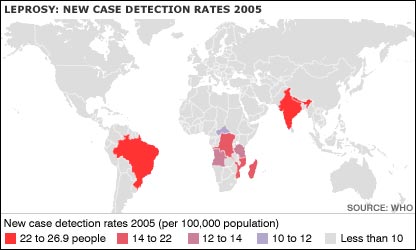While reading a school paper today, I read an article on a girl who went to Vietnam to film a documentary on those who are affected by leprosy. The only time I have heard this term used before is in the Bible, notably when Jesus lays hands on a leper to heal him. Throughout history lepers have been cast out of their societies to live a life as an outcast. After researching it, I became increasingly intrigued to see how many public health care initiatives were taken to lessen the prevalence of this disease. Although nearly non-existent in the United States, it is still an interesting historical and global matter.
Pathology: Leprosy is caused by a very slow-reproducing bacteria transmitted through droplets from the nose and mouth (although there is not full agreement in the medical community as to how this is transmitted). The incubation period averages five years, and it can take up to twenty years before the symptoms appear. It causes nerve damage in the arms and legs, muscle weakness, sensory loss, and large disfiguring nodules on the skin.
Symptoms:
- Skin lesions that have lighter color than normal skin tone
- Decreased sensation to heat, pain, or touch
- Lesions that do not heal
- Numbness in the hands, feet, arms, and legs
- Muscle weakness
Treatment: The most effective current treatment is a multi-drug antibiotic course. This antibiotic course includes the drugs dapsone, rifampicin, and clofazimine. Once given the treatment, patients are no longer contagious and are cured completely within 6-12 months.
Mortality (# of deaths): about 4,000 deaths per year
Morbidity (incidences): about 500,000 new cases each year
Epidemiology: This problem is seen mostly in Africa, Asia, and Latin America. The worst epidemics are in the following five countries: Brazil, India, Madagascar, Mozambique, and Nepal. Males acquire this disease twice as much as females.
Public Health/ Development Economics: The WHO has taken great measures to eradicate this disease, and have been successful doing so. Since 1995, they have offered free multi-drug treatment to anyone who is diagnosed with leprosy. It has been proven that since the early 1990s, the rates of new cases of leprosy have decreased by around 20% each year. The WHO has also been able to prevent an multi-drug resistant strains.
For More Information:




“The only time I have heard this term used before is in the Bible, notably when Jesus lays hands on a leper to heal him.”
Excellent post on this particular disease. I enjoyed reading it thoroughly, however, it would was quite surprising to me that you did not hear the term “leprosy” before today, except as you noted. It surprises me because usually people in the medical community are quite aware of this term. Also, leprosy is fairly well-known term in the English vernacular. Anyway, I like your stats and graphs!
By: Om on December 1, 2007
at 3:54 pm
Perhaps I should have better clarified. I definitely knew that leprosy still existed in the world, but it typically is not something I have heard discussed in United States news because it has such a low prevalence here. So, I have heard about it most in the Bible or in the context of Biblical times. I’m glad you enjoyed it!
By: keherenf on December 1, 2007
at 4:25 pm